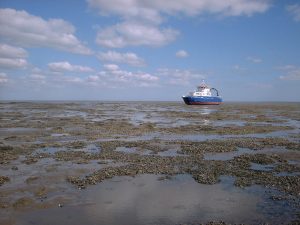Handworking
Many of commercial fisheries in the EIFCA District are within tidal embayments, estuaries and natural harbours, where much of the seabed is uncovered at low tide. Molluscan shellfish such as cockles, mussels and oyster are often harvested at low water, either accessed directly from the shore or by sea. Fishermen in The Wash steam out to the shellfish beds and either row ashore on a small boat or skiff, or (more commonly) simply wait for the tide to go away, leaving the boat high and dry. This practice, often referrred to as “laying on”, is made possible by the shape of the boat’s hull.
 Our own survey boat, RV Three Counties, often lays on so that Officers can conduct inspections and foot surveys of the cockle and mussel beds; she has extra reinforcement so that the hull is strong enough to take the weight of the boat and the propellors are not damaged.
Our own survey boat, RV Three Counties, often lays on so that Officers can conduct inspections and foot surveys of the cockle and mussel beds; she has extra reinforcement so that the hull is strong enough to take the weight of the boat and the propellors are not damaged.
 Once they can access the beds, fishermen harvest the shellfish by hand, generally using tools including rakes and nets. The shellfish is usually placed in bags, which are then taken ashore to be sold. Some fishermen maintain “lays”, which are cultivated plots of seabed leased from a landowner or the Crown Estate.
Once they can access the beds, fishermen harvest the shellfish by hand, generally using tools including rakes and nets. The shellfish is usually placed in bags, which are then taken ashore to be sold. Some fishermen maintain “lays”, which are cultivated plots of seabed leased from a landowner or the Crown Estate.
In addition to removing shellfish from their lays to be sold, fishermen also add to (restock) them and spend time checking on them, to ensure good growth. In some of the harbours in the EIFCA District, oysters are grown on trestles; these, too, must be tended to and maintained in order to yield a good product.
